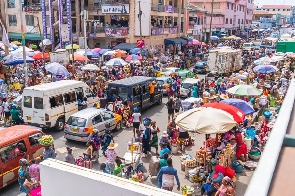Economic growth slowed to 3.7 percent in the fourth quarter (Q4) of 2022 compared to 5.6 percent in the same period of 2021, according to provisional data released by Ghana Statistical Services (GSS).
The provisional real quarterly gross domestic product (GDP) data indicate that non-oil GDP also declined – from 6.9 percent in 2021 to 4.3 percent in Q4 2022.
Government had revised its growth projection down to 3.7 percent from 5.8 percent initially forecasted for 2022, as well as 4.3 percent for non-oil growth due to the challenging macroeconomic environment.
While the economy experienced a slowdown in Q4 2022, some sub-sectors recorded significant growth rates. The Services sector had the highest growth rate at 7.6 percent, followed by the agriculture sector which grew 3.6 percent while the industry sector contracted by 1 percent, according to the report by GSS.
The mining and quarrying, information and communication, public administration, defence and social security, crops, and education sub-sectors were the main drivers of GDP growth in Q4 2022. Information and communication saw an expansion of 20.5 percent; public administration, defence and social security, 15.7 percent; mining and quarrying, 13.4 percent; and education 12.3 percent. Health and social work also grew by 10.5 percent.
On the other hand, seven sub-sectors contracted in Q4 2022.
These include: water supply, sewerage, waste management and remediation activities, -13.4 percent; real estate, -13.4 percent); electricity, -12.8 percent; manufacturing, -9.6 percent; professional, administrative and support service activities, -7.7 percent; construction, -7.1 percent; and fishing, -1.5 percent.
The Bank of Ghana’s composite Index of Economic Activity (CIEA) for January 2023 indicated a contraction in economic activity by 7.6 percent compared to a growth rate of 4.2 percent in the same period of 2022, a continuation of the contraction by 6.2 percent in November 2022. The main indicators that weighed down the index during the period were port activity, cement sales, imports and credit to the private sector.
Quarter-on-quarter growth
In terms of quarter-on-quarter seasonally adjusted growth rates, the agriculture sector expanded by 1.0 percent in Q4 2022, while the industry sector contracted by 0.2 percent (quarter-on-quarter). The mining and quarrying sub-sector declined from 3.7 percent in Q3 2022 to 3.2 percent in Q4 2022.
The manufacturing sub-sector contracted further by 0.7 percentage points in Q4 2022 compared to the -1.8 percent contraction in Q3 2022. There were contractions in water supply, sewerage, waste management and remediation activities (-17.7 percent), real estate (-11.3 percent) and construction (-4.1 percent).
Despite contraction in the industry sector, some sub-sectors within it recorded growth. The electricity sub-sector, for instance, recorded growth of 2.7 percent – which was higher than the 0.8 percent growth rate recorded in the third quarter of 2022.
Furthermore, the report highlights that the challenging macroeconomic environment is the primary reason for the slowdown in Ghana’s economy in Q4 2022. The country is currently facing various macroeconomic challenges – including high inflation, a weakening currency and rising debt levels, which have impacted economic growth.
Despite these challenges, the report shows that some sub-sectors within the economy continue to perform well – indicating the resilience of Ghana’s economy. However, more needs to be done to address the macroeconomic challenges to ensure sustainable economic growth.
The potential International Monetary Fund (IMF) US$3billion extended credit facility (ECF) programme, which awaits board approval possibly in May 2023, could help Ghana’s economy recover by providing the country with necessary funds to address some of its macroeconomic challenges.
Business News of Thursday, 20 April 2023
Source: thebftonline.com

















